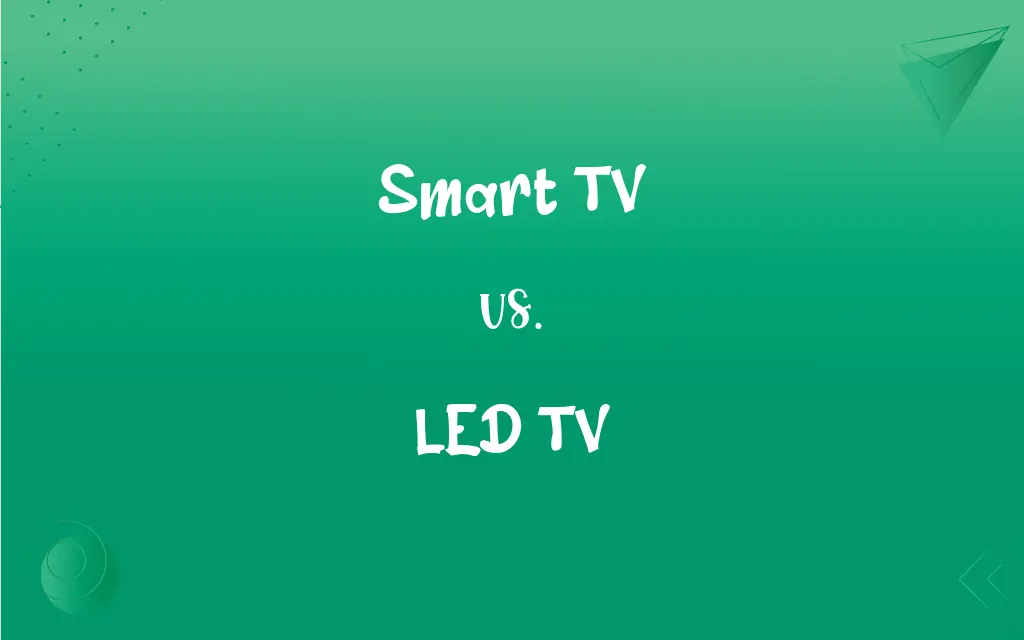Smart TV vs. LED TV: What's the Difference?
By Harlon Moss & Janet White || Updated on September 30, 2023
A Smart TV connects to the internet and supports apps, while an LED TV refers to the display technology using light-emitting diodes.

Key Differences
The smart TV encompasses features enabling internet connectivity and access to a multitude of apps and streaming services, enhancing user interaction with diverse content. In contrast, an LED TV, though it may deliver crystal-clear images via its light-emitting diode technology, does not inherently possess smart functionalities.
Delving into functionality, smart TVs open a gateway to a plethora of online services, such as Netflix and Hulu, by incorporating operating systems that support apps and internet browsing. LED TVs, on the other hand, are primarily concerned with delivering high-quality visuals through the efficient and vibrant illumination provided by LEDs.
A smart TV often intertwines with other smart home devices, providing a centralized interaction platform for lighting, thermostats, and more, acting as a technological hub. LED TVs might lack this intricate connectivity, focusing solely on visual display rather than interactive technological orchestration.
From a user perspective, smart TVs offer an interactive and dynamic user experience, allowing content streaming, online browsing, and even gaming through various apps. LED TVs may offer stunning picture quality and are available in various sizes and price ranges but do not offer extensive interactive features unless paired with external devices.
In financial contemplation, smart TVs tend to be positioned at a higher price point due to their advanced features and capabilities. LED TVs might be more budget-friendly, offering superior image quality without the additional cost of integrated smart technologies.
ADVERTISEMENT
Comparison Chart
Internet Connectivity
Has built-in internet connectivity
Lacks inherent internet connectivity
Apps and Features
Supports various apps and streaming services
Does not support apps
Technological Focus
Geared towards interactive and smart features
Focused on display technology
Price Point
Generally more expensive due to added features
Typically more budget-friendly
Integration
Can often integrate with other smart devices
Limited integration capabilities
ADVERTISEMENT
Smart TV and LED TV Definitions
Smart TV
Internet-Enabled.
The smart TV allows us to browse websites.
LED TV
Light-Emitting Display.
The LED TV provides bright visuals.
Smart TV
Streaming Capable.
We watch YouTube directly on the smart TV.
LED TV
Limited Interactivity.
The LED TV does not support apps or browsing.
Smart TV
App Accessible.
Netflix is available on our smart TV.
LED TV
Non-Smart Functionality.
Our LED TV doesn’t have internet access.
Smart TV
Interactive Platform.
You can play games on the smart TV.
LED TV
Energy Efficient.
The LED TV uses less power than older models.
Smart TV
Interconnected Device.
The smart TV controls our smart home devices.
LED TV
Crystal Clear Images.
Films on the LED TV are incredibly vibrant.
FAQs
What is a smart TV?
A smart TV can connect to the internet and has built-in apps.
Can I mirror my phone to a smart TV?
Yes, most smart TVs support screen mirroring.
Do all smart TVs have the same features?
No, features can vary widely between brands and models.
Is a smart TV always LED?
Not always, but many modern smart TVs use LED displays.
Can LED TVs stream content?
Only if paired with a streaming device.
Are smart TVs more expensive than LED TVs?
Generally yes, due to their additional features.
What defines an LED TV?
An LED TV uses light-emitting diodes for its display.
Can I browse the internet on an LED TV?
No, not without connecting it to a smart device.
Can I upgrade my LED TV to a smart TV?
Yes, using external devices like streaming sticks.
Can LED TV displays vary in quality?
Yes, different models may have varying display qualities.
Can a smart TV function as a computer monitor?
Yes, if it has the necessary input ports.
Can smart TVs be controlled via voice?
Many smart TVs do offer voice control features.
Are LED TVs always non-smart?
Not necessarily; some LED TVs may have smart features.
Can I install apps on an LED TV?
No, you cannot install apps on a standard LED TV.
Is a smart TV better than an LED TV?
It depends on your needs: smart for features, LED for display.
About Author
Written by
Harlon MossHarlon is a seasoned quality moderator and accomplished content writer for Difference Wiki. An alumnus of the prestigious University of California, he earned his degree in Computer Science. Leveraging his academic background, Harlon brings a meticulous and informed perspective to his work, ensuring content accuracy and excellence.
Co-written by
Janet WhiteJanet White has been an esteemed writer and blogger for Difference Wiki. Holding a Master's degree in Science and Medical Journalism from the prestigious Boston University, she has consistently demonstrated her expertise and passion for her field. When she's not immersed in her work, Janet relishes her time exercising, delving into a good book, and cherishing moments with friends and family.
































































